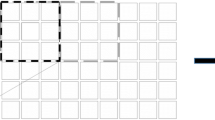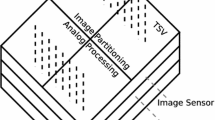Abstract
In this paper a programmable imager with averaging will be described which is intended for averaging of different groups or sets of pixels formed by n × n kernels, n × m kernels or independent pixels of the array. This imager is a 64 × 64 array which uses passive pixels that can be randomly accessed. The read-outstage includes a sole charge amplifier with programmable gain, a sample-and-hold structure and an analog buffer. This read-out structure is different from other existing imagers with variable resolution since it uses a sole charge amplifier, whereas the normal structure is an operational amplifier per column plus a global operational amplifier. This structure will be described in detail indicating the advantages and disadvantages with respect to other imagers with averaging capabilities. This programmable resolution architecture can be more appropriate, and eventually, more efficient, when implementing very high speed Cellular Neural Network (CNN) processors in a CNN chipset—a mixed-signal hardware platform for CNN-based image processing. A significant processing time reduction can be obtained when decreasing the image resolution, and therefore the amount of information to be transferred to the CNN processor. This programmable resolution can also be used for fast image recognition and ulterior windowing at full resolution in a reduced area of the image, permitting a more accurate processing of the region of interest. In addition, full resolution images can still be obtained, as in commercial imagers which are usually included in CNN chipsets.
Similar content being viewed by others
References
E.R. Fossum, “CMOS image sensors: Electronic camera on a chip,” Int. Electron Device Meetings, pp. 17–25, 1995.
H.-S. Wong, “Technology and device scaling considerations for CMOS imagers,” IEEE Transactions on Electron Devices, Vol. 43, No. 12, pp. 2131–2142, 1996.
G. Meynants, B. Dierickx, and D. Scheffer, “CMOS active pixel image sensor with CCD performance,” Proceeding SPIE, Vol. 3410, pp. 68–76, 1998.
T. Roska, “CNN chip set architectures and the visual mouse,” Proceedings of the 4th IEEE Int. Workshop on Cellular Neural Networks and their Applications, Sevilla, Spain, pp. 487–492, June 1996.
Z. Zhou, B. Pain, and E.R. Fossum, “Frame-transfer CMOS active pixel sensor with pixel binning,” IEEE Transactions on Electron Devices, Vol. 44, No. 10, pp. 1764–1768, 1997.
Z. Zhou, B. Pain, and E.R. Fossum, “A CMOS imager with onchip variable resolution for light-adaptive imaging,” Proceeding of the IEEE International Solid-State Circuits Conference, pp. 174–175, 1998.
N. Ricquier, I. Debusschere, B. Dierickx, A. Alaerts, J. Vlummens, and C. Claeys, “The CIVIS sensor: a flexible smart imager with programmable resolution,” Proceeding SPIE, Vol. 2172, pp. 2–10, 1994.
C. Jansson, P. Ingelhag, C. Svensson, and R. Forchheimer, “An addressable 256 × 256 photodiode image sensor array with an 8-bit digital output,” Analog Integrated Circuits and Signal Processing, Vol. 4, pp. 37–49, 1993.
S.E. Kemeny, R. Panicacci, B. Pain, L. Matthies, and E.R. Fossum, “Multiresolution image sensor,” IEEE Transactions on Circuits and Systems for Video Technology, Vol. 7, No. 4, pp. 575–583, 1997.
K.R. Crounse and L.O. Chua, “The CNN universal machine is as universal as a Turing machine,” IEEE Transactions on Circuits and Systems I: Fundamental Theory and Applications, Vol. 43, No. 4, pp. 353–355, April 1996.
T. Roska and L.O. Chua, and A. Zarandy, “Language, compiler and operating system for the CNN supercomputer,” Report UCB/ERL M93/34, University of California, Berkeley, 1993.
S. Espejo, A. Rodríguez-Vázquez, and R. Domínguez-Castro, “Smart-pixel cellular neural networks in analog current-mode CMOS technology,” IEEE Journal of Solid-State Circuits, Vol. 29, pp. 895–905, IEEE Aug. 1994.
S. Espejo, R. Domínguez-Castro, G. Liñán, and A. Rodríguez-Vázquez, “64 × 64 CNN Universal Chip with Analog and Digital I/O,” IEEE 1998 Int. Conf. on Electronic Circuits and Systems, Lisbon, Sep. 1998.
Author information
Authors and Affiliations
Rights and permissions
About this article
Cite this article
Roca, E., Espejo, S., Domínguez-Castro, R. et al. A Programmable Imager for Very High Speed Cellular Signal Processing. The Journal of VLSI Signal Processing-Systems for Signal, Image, and Video Technology 23, 305–318 (1999). https://doi.org/10.1023/A:1008193018623
Published:
Issue Date:
DOI: https://doi.org/10.1023/A:1008193018623




